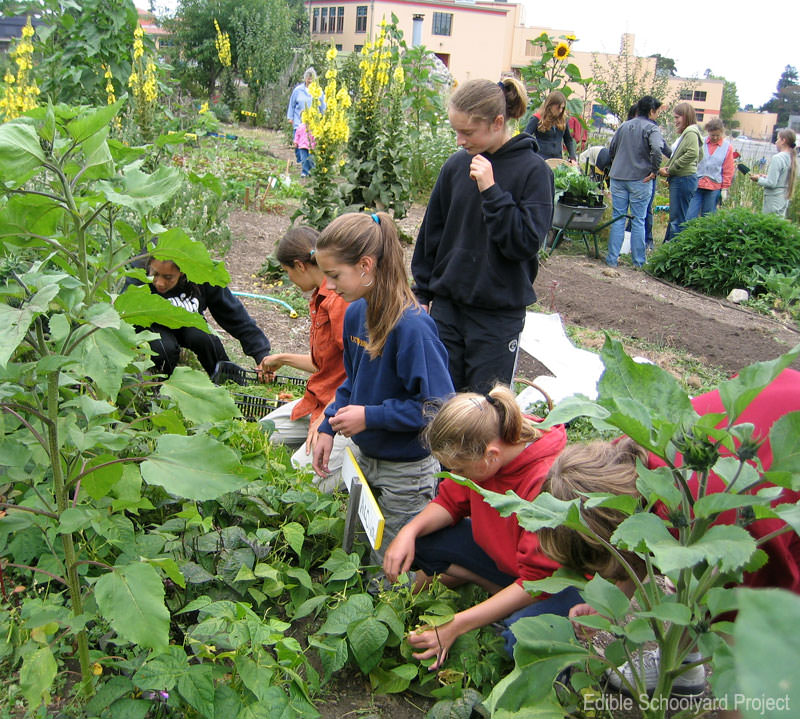
 Courtesy Edible Schoolyard Project |
Even if you’ve never heard the term “edible education,” there’s a good chance a school in your community is a part of this movement, integrating academics with growing, cooking and sharing wholesome food.
Picture students walking through the schoolyard to identify and harvest wild edible plants or learning about chemical reactions while baking with yeast in a kitchen classroom. Couple these types of experiences with free, daily, nutritious school lunches, perhaps grown by the students themselves, and you’ll get a better understanding of what edible education is all about.
If edible education hasn’t taken root in your area schools yet, don’t fret: The Edible Schoolyard Project continues to gain momentum across the country. The project’s basic mission is to build and share a sustainable-food curriculum for all schools, in all grades, through hands-on learning in garden and kitchen classrooms.
The project is the brainchild of Alice Waters, chef, author and vice president of Slow Food International, a nonprofit organization that promotes and celebrates local artisanal food. Waters, who owns Chez Panisse restaurant in Berkeley, Calif., which has worked with local farmers to serve sustainably and locally produced foods for more than 40 years, advocates edible education in public schools as a “delicious revolution,” in which school-lunch programs are enriched with experiences in the garden.
“The Edible Schoolyard Project continues to flourish from one simple idea: all academic subjects from kindergarten through 12th grade become more richly engaging when they are integrated with immersive experiences in kitchens and gardens,” Waters writes in the September 2013 Slow Food USA newsletter. “As young people are empowered to understand the deep connections between food and every other aspect of life, they develop a sense of global citizenship, a respect for the land, and a determination to nourish themselves and each other.”
The project dates back to 1996, when Waters was inspired to transform a rundown schoolyard at an urban middle school in Berkeley into a 1-acre garden and build an adjacent teaching kitchen that could benefit the school curriculum and community. The garden and kitchen slowly took shape with funding from the Center for Ecoliteracy and help from teachers, parents and community members.
Now 17 years later, Edible Schoolyard Berkeley not only continues to serve King Middle School and the surrounding community but has also become a model for national and international edible-education programs, hosting 1,000 visitors each year who are interested in learning more about the edible-education curriculum. The school garden has expanded through the years to include more than 100 varieties of seasonal vegetables, berries, vines, flowers and fruit trees. It is now complemented by 3,500-gallon cisterns that collect rainwater for irrigation and a chicken coop, which supplied more than 500 eggs used in the kitchen classroom last year. In all, ESY Berkeley has served more than 7,000 students and today has a staff of nine, including five teachers, fully supported by the Edible Schoolyard Project.
A nationally recognized program of the Edible Schoolyard Project is the School Lunch Initiative, implemented in 2003 to bridge the kitchen and garden classroom at ESY Berkeley with the actual food served to students in the lunchroom, granting students opportunities to be involved in growing, harvesting and preparing the food they eat. Serving the entire school district as a central kitchen, the new Dining Commons at King Middle School provides 10,000 meals per day, made with fresh and mostly organic ingredients.
“Right there, in the middle of every school day, lies time and energy already devoted to the feeding of children,” Waters writes in her book, Edible Schoolyard: A Universal Idea (Chronicle Books, 2008). “We have the power to turn that daily school lunch from an afterthought into a joyous education, a way of caring for our health, our environment and our community.”
Formerly known as the Chez Panisse Foundation, the Edible Schoolyard Project took its current name in 2011 and expanded its mission of building and sharing an edible education curriculum for kindergarten through high school. In addition to supporting ESY Berkeley, the project now promotes edible-education programs across the country through an online network and resource center and offers professional-development opportunities at its annual Edible Schoolyard Academy. The Edible Schoolyard Project’s network now comprises 2,354 locations, including 2,218 garden classrooms, 477 academic classrooms, 378 kitchen classrooms, 233 cafeterias, 48 support organizations and 13 businesses.
To find an edible education program in your area or learn how to start one, visit the Edible Schoolyard Project website.




